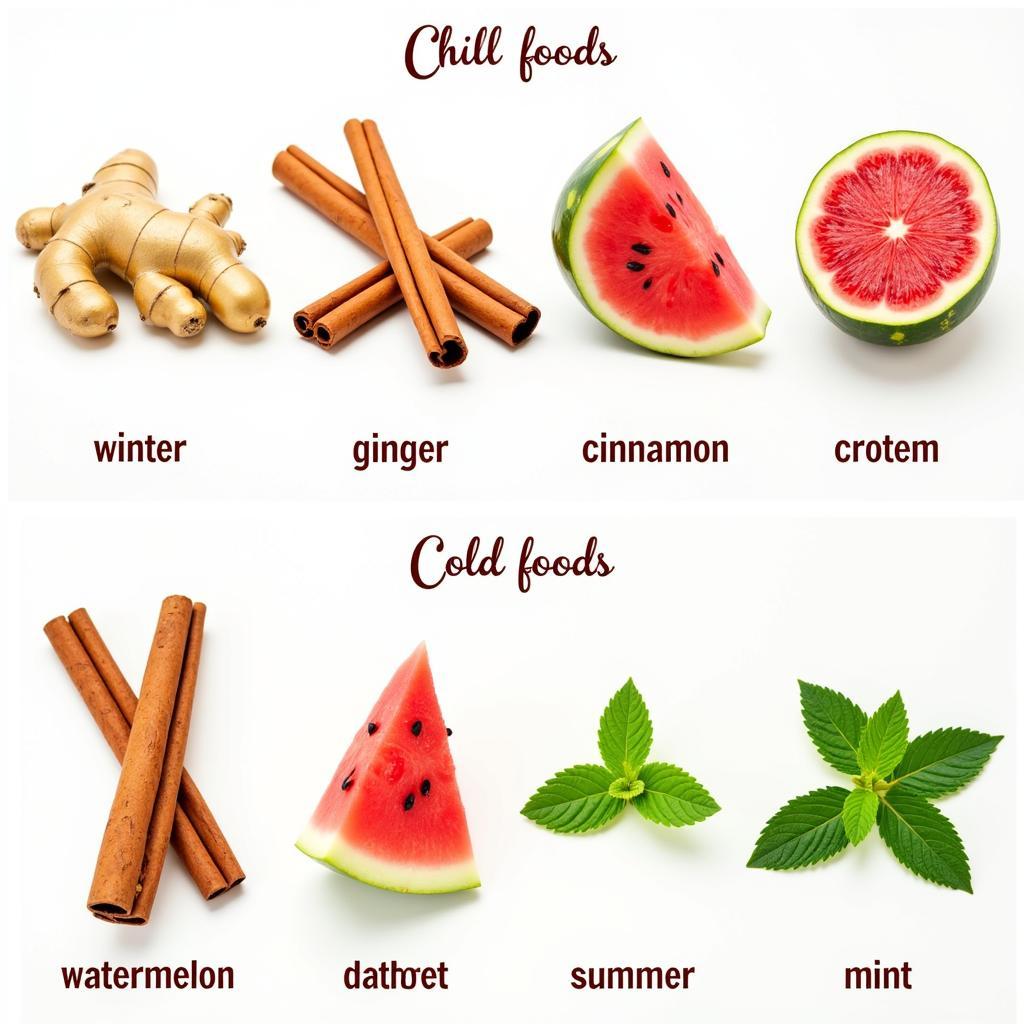The Chinese “hot and cold foods chart” isn’t about actual temperature, but rather a system of classifying foods based on their perceived energetic effects on the body. This concept is deeply rooted in Traditional Chinese Medicine (TCM) and influences dietary choices for maintaining balance and well-being. Understanding this chart can help you harmonize your diet and optimize your health, according to TCM principles.
Understanding the Principles of the Chinese Hot and Cold Foods Chart
TCM views food as more than just calories and nutrients; it sees food as possessing energetic properties that can either warm or cool the body. This isn’t about the physical temperature of the food but about its inherent nature. For instance, a “hot” food like ginger can warm you up, while a “cold” food like watermelon can help cool you down. The chinese ‘hot and cold foods chart’ helps categorize these foods. This balance is essential for maintaining health in TCM. After the introduction, you’ll find a detailed yin yang food chart.
The concept of “hot” and “cold” relates to the balance of Yin and Yang, fundamental forces in TCM. Yin represents coolness, passivity, and moisture, while Yang represents heat, activity, and dryness. Foods are classified along this spectrum, helping individuals adjust their diets based on their individual constitution and the surrounding environment. So, if you’re feeling sluggish and cold, incorporating more “warming” foods might be beneficial. Conversely, if you’re experiencing heatiness, “cooling” foods are recommended.
How to Use the Chinese Hot and Cold Foods Chart in Your Daily Life
Navigating the chinese ‘hot and cold foods chart’ can seem daunting, but it doesn’t have to be. Start by observing your body’s reactions to different foods. Do you feel energized or sluggish after certain meals? Do you experience digestive discomfort? These clues can help you identify what your body needs. Remember, this is about personalized balance.
Think about the seasons too. In winter, incorporating warming foods like ginger, cinnamon, and root vegetables can help combat the cold. During summer, cooling foods like cucumber, watermelon, and mint can provide relief from the heat. Using the yin and yang food chart can assist you in selecting appropriate foods for each season.
What are some examples of hot foods?
Hot foods include ginger, garlic, chili peppers, and lamb.
What are some examples of cold foods?
Cold foods include watermelon, cucumber, mint, and seaweed.
 Seasonal Chinese Hot and Cold Foods
Seasonal Chinese Hot and Cold Foods
“The key to using the hot and cold food chart effectively is understanding your individual needs and adapting the principles to your lifestyle,” says Dr. Li Wei, a renowned practitioner of Traditional Chinese Medicine. It’s not about strict adherence but about mindful eating and finding what works best for you. The chinese medicine warming foods guide can be helpful in identifying foods to incorporate during colder months.
Debunking Common Misconceptions about the Chinese Hot and Cold Foods Chart
One common misconception is that all spicy foods are “hot.” While many spices are indeed warming, some, like mint, are considered cooling. Similarly, the temperature at which food is served doesn’t determine its classification. A cold salad with warming ingredients can still have a net “hot” effect. For a comprehensive list, refer to the hot and cold foods list.
“It’s important to remember that the ‘hot’ and ‘cold’ designations aren’t absolute,” explains Dr. Mei Lin, a respected expert in Chinese dietary therapy. “The effect of a food can vary depending on how it’s prepared and combined with other ingredients.”
In conclusion, the chinese ‘hot and cold foods chart’ offers a valuable framework for understanding the energetic properties of food and their impact on our well-being. By incorporating these principles into our daily diets, we can strive for a more balanced and harmonious approach to nutrition. Download our yin yang food chart pdf for a handy reference.
FAQ
- Is the Chinese hot and cold food chart about the actual temperature of the food? No, it’s about the energetic properties of the food.
- What is the purpose of the chart? To help individuals balance their diet based on TCM principles.
- How do I know if a food is hot or cold? Refer to the chart and observe your body’s reactions to different foods.
- Do I have to strictly follow the chart? No, it’s about finding a balance that works for you.
- Are all spicy foods considered hot? No, some spices like mint are considered cooling.
- Does cooking temperature affect a food’s classification? No, it’s the inherent nature of the food that matters.
- Where can I find a reliable chart? You can find many resources online and in books on TCM.
Need further assistance? Contact us at Phone Number: 02437655121, Email: minacones@gmail.com or visit us at 3PGH+8R9, ĐT70A, thôn Trung, Bắc Từ Liêm, Hà Nội, Việt Nam. We have a 24/7 customer service team.